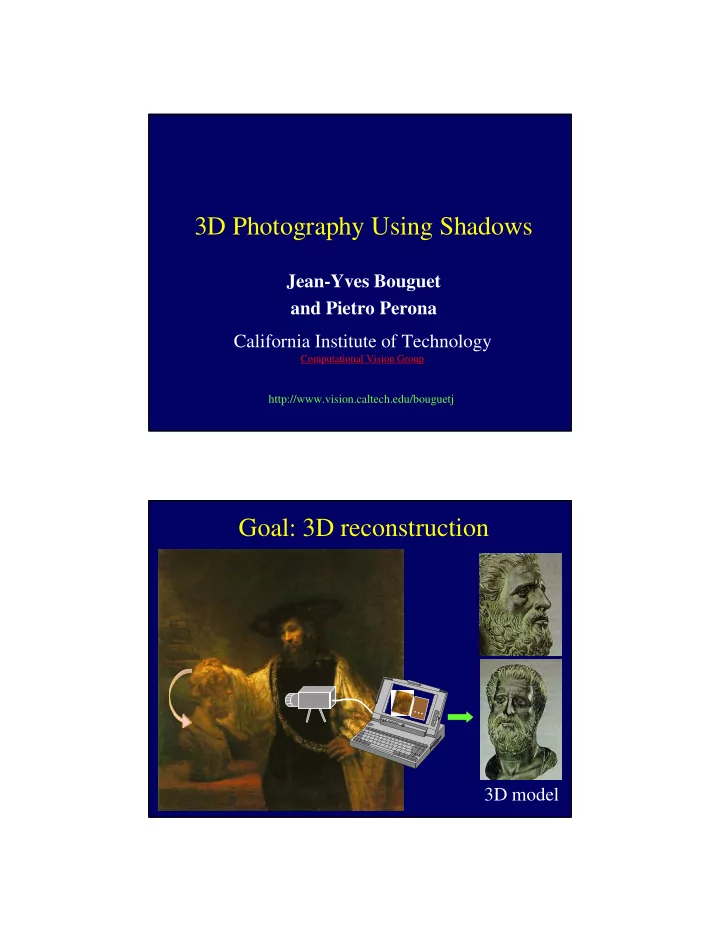

3D Photography Using Shadows Jean-Yves Bouguet and Pietro Perona California Institute of Technology Computational Vision Group http://www.vision.caltech.edu/bouguetj Goal: 3D reconstruction ... 3D model
State of the art • Accurate • Bulky • Complicated • Cost: >10k$ Weak structured lighting system
The idea Desk Stick or Lamp pencil Time t Camera Desk [Bouguet and Perona’98] The geometry Stick S S Stick or Desk pencil Lamp Π Π Desk P Camera P Π d p = ∩ Π ( , ) P O p p O Image Camera
The geometry Stick S S Stick or Desk pencil Lamp Π Π Desk Λ Camera Π d λ Λ = λ ∩ Π ( , ) O d λ Π = ( Λ , ) S O Image Camera The geometry S Π v Λ 2 S Π Π Λ 1 Π d λ 2 λ 2 Λ = λ ∩ Π λ 1 ( , ) O 1 1 d Λ = λ ∩ Π ( , ) O O 2 2 Image v λ 1 Camera Π = Λ 1 Λ ( , ) 2
Temporal processing Spatio-temporal processing x t s (p) = 133.27 Time t y Time t Spatial processing p x ref = 130.6 t s (p) = 133.27 [Kanade’91,Curless’95] Column pixel coordinate x Camera calibration [Tsai’87, Abdel-Aziz and Karara’71] • Position of the desk plane • Internal parameters of the camera
Lamp calibration S S ∆ ∆ T T s ∈ ∆ Pencil S h B Π d Desk t s t s b O b Image Camera [Thales ~585BC] Vertical plane Π v calibration Λ Ι { } Π d λ Π , I v Π d λ Ι λ Ι O Image Camera
Angel experiment Accuracy: 0.1mm over 10cm ~ 0.1% error Skull experiment Accuracy: 0.1mm over 10cm ~ 0.1% error
Textured objects Other objects
Pot-pourri scan Accuracy: 0.5mm over 50cm ~ 0.1% error Scanning with the sun Accuracy: 1mm over 50cm ~ 0.5% error
Scanning with the sun Accuracy: 1cm over 2m ~ 0.5% error Error analysis 1 1 σ ∝ ⋅ ⋅ σ 2 2 ∇ Z I 2 2 d I Variance of the error Image brightness noise in depth estimate ∇ : shadow edge sharpness I d : distance of the (image gradient) shadow plane Π to the camera optical center [Bouguet’99]
Real-time implementation • Performance: 30Hz, 320x240, Pentium II 300MHz • Single shadow pass: 20 - 30 seconds (600-900 frames) • Refined scanning: 1 - 2 minutes Conclusions Low cost and simple technique for dense 3D shape acquisition Does not work with specular or dark objects
What’s next? • Registration of multiple scans complete models [Turk’94, Curless’96] References (1) Space-time analysis: • B. Curless and M. Levoy, “Better optical triangulation through spacetime analysis”, ICCV95, pages 987-993, June 1995 • T. Kanade, A. Gruss and L. Carley, “A very fast VLSI rangefinder”, IEEE International Conference on Robotics and Automation, volume 39, pages 1322-1329, April 1991 Camera calibration: • R. Y. Tsai, “A versatile camera calibration technique for high accuracy 3D machine vision metrology using off-the-shelf TV cameras and lenses”, IEEE J. Robotics Automat., RA-3(4):323-344, 1987 • Y. I. Abdel-Aziz and H. M. Karara, “Direct linear transformation into object space coordinates in close-range photogrammetry”, Proc. ASP Symposium on Close-Range Photogrammetry, Urbana, Illinois, pages 1-18, 1971
References (2) Multiple view registration: • G. Turk and M. Levoy, “Zippered polygon meshes from range images”, SIGGRAPH’94, pages 311-318, July 1994 • B. Curless and M. Levoy, “A volumetric method for building complex models from range images”, SIGGRAPH’96, 1996 Shadow scanning: • J.-Y. Bouguet and P. Perona, “3D Photography on your desk”, ICCV’98, pages 43-50, January 1998 available at: http://www.vision.caltech.edu/bouguetj/ICCV98/ • J.-Y. Bouguet, “Passive and Active visual techniques for 3D modeling”, Ph.D. thesis, California Institute of Technology, June 1999 available at: http://www.vision.caltech.edu/bouguetj/ References (3) Related work on shape from shadows: • D. J. Kriegman and P. N. Belhumeur, “What Shadows Reveal About Object Structure”, ECCV’98, pages 399-414, June 1998 • J. J. Clark, and L. Wang ,” Trajectories for Optimal Temporal Integration in Active Vision Systems”, Proceedings of the International Conference on Robotics and Automation, Albuquerque, April, 1997, pages 431-436 • M. Daum and G. Dudek, “On 3-D Surface Reconstruction Using Shape from Shadows”, CVPR’98, pages 461-468, June 1998 • J.-Y. Bouguet, M. Weber and P. Perona, “What do planar shadows tell us about scene geometry?”, CVPR’99, June 1999
Recommend
More recommend